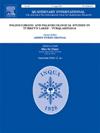Chert sources and territorial behaviour after the Neolithization process: An exploratory analysis from Grotta Battifratta (Rieti, Central Italy)
IF 1.9
3区 地球科学
Q3 GEOGRAPHY, PHYSICAL
引用次数: 0
Abstract
This paper aims at investigating lithic raw material acquisition strategies and human mobility in the Sabina region (Central Italy) during the Neolithic period through the Non-destructive Multiparametric Protocol for Chert Investigation (NM-PCI) applied to the lithic assemblage of Grotta Battifratta (Sabina region, Rieti). Despite its importance as a unique natural bridge in the middle of the Italian peninsula, Sabina has long been archaeologically underestimated. Moreover, although rich in siliceous rock sources, a solid knowledge of chert availability and distribution is lacking. By applying a pilot analysis on raw material provenance, this work aims at shedding light on i.) chert-bearing deposits in the region and ii.) human territorial behaviour. Furthermore, the preliminary characterization data of the Sabina chert is presented here as part of the first project of construction of a geological reference collection, currently lacking for the area. Geological samples and the lithic assemblage of Grotta Battifratta have been characterized by applying petrographical, geochemical (pXRF) and colorimetric analysis (CIELab). Multivariate statistics is employed to explore chert variability and to assess the geographic origin of the raw material exploited at the archaeological site. The preliminary results suggest a strong reliance on local sources together with a short but significant introduction of exogenous raw material, whose origin is still under investigation. This research presents a preliminary analysis of chert in the Sabina region and provides a novel strategy to current research in lithic raw material provenance in the Central Italy.
新石器时代后的燧石来源和领土行为:来自Grotta Battifratta(意大利中部Rieti)的探索性分析
本文旨在通过应用于Grotta Battifratta (Sabina地区,Rieti)的岩石组合的非破坏性多参数燧石调查协议(NM-PCI),研究新石器时代Sabina地区(意大利中部)的石器原材料获取策略和人类流动性。尽管萨比纳是意大利半岛中部一座独特的天然桥梁,但长期以来,考古学家一直低估了它的重要性。此外,虽然硅质岩资源丰富,但缺乏对燧石可利用性和分布的扎实认识。通过对原材料来源进行试点分析,这项工作旨在阐明i.)该地区含燧石矿床和ii.)人类领土行为。此外,本文还介绍了Sabina燧石的初步特征数据,作为建设该地区目前缺乏的地质参考资料收集的第一个项目的一部分。采用岩石学、地球化学(pXRF)和比色分析(CIELab)对Grotta Battifratta的地质样品和岩石组合进行了表征。多元统计被用来探索燧石的变异性,并评估在考古遗址开采的原材料的地理来源。初步结果表明,大量依赖当地来源,同时还大量引入外源原料,其来源仍在调查中。本研究对萨比纳地区的燧石进行了初步分析,并为目前意大利中部的岩屑原料来源研究提供了一种新的策略。
本文章由计算机程序翻译,如有差异,请以英文原文为准。
求助全文
约1分钟内获得全文
求助全文
来源期刊

Quaternary International
地学-地球科学综合
CiteScore
5.60
自引率
4.50%
发文量
336
审稿时长
3 months
期刊介绍:
Quaternary International is the official journal of the International Union for Quaternary Research. The objectives are to publish a high quality scientific journal under the auspices of the premier Quaternary association that reflects the interdisciplinary nature of INQUA and records recent advances in Quaternary science that appeal to a wide audience.
This series will encompass all the full spectrum of the physical and natural sciences that are commonly employed in solving Quaternary problems. The policy is to publish peer refereed collected research papers from symposia, workshops and meetings sponsored by INQUA. In addition, other organizations may request publication of their collected works pertaining to the Quaternary.
 求助内容:
求助内容: 应助结果提醒方式:
应助结果提醒方式:


